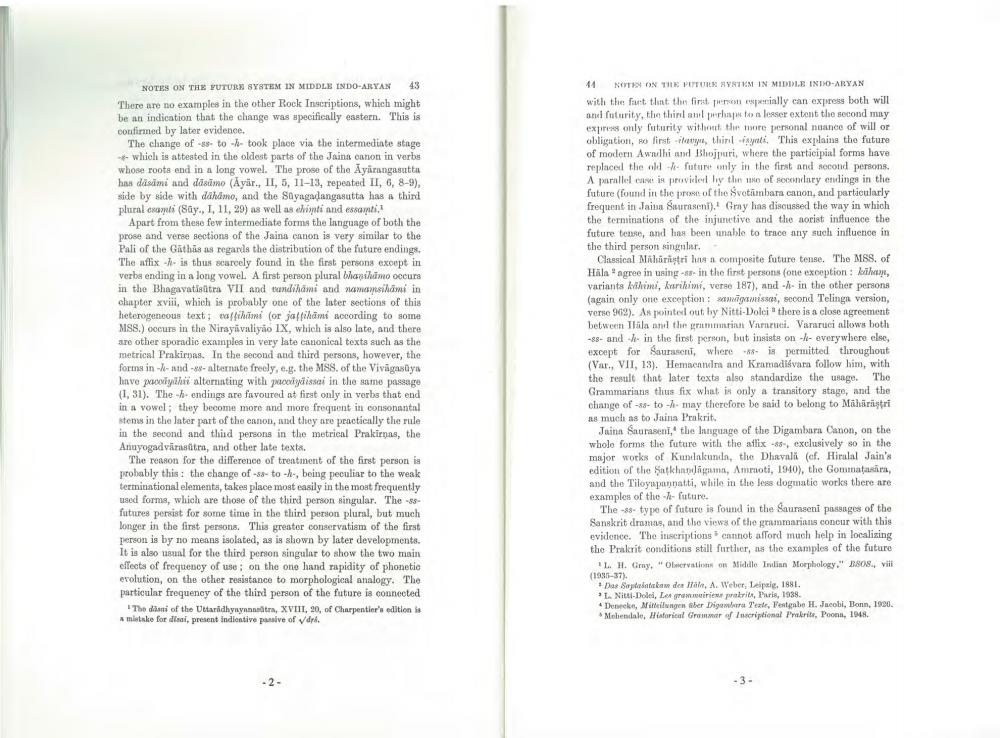________________
NOTES ON THE FUTURE SYSTEM IN MIDDLE INDO-ARYAN 43 There are no examples in the other Rock Inscriptions, which might be an indication that the change was specifically eastern. This is confirmed by later evidence.
The change of s to -- took place via the intermediate stage
which is attested in the oldest parts of the Jains canon in verbs whose roots end in a long vowel. The prose of the Ayarangasatta han disime and dame (Ayar., II, 5, 11-13, repeated II, 6, 8-9). side by side with dihime, and the Soyagadangnutta has a third plural orali (Say., 1, 11, 29) as well as chipt and escanti?
Apart from these few intermediate forms the Inngange of both the prose and verse sections of the Jains onnon is very similar to the Pali of the Gathis as regards the distribution of the future endings The aflix is thus scarcely found in the first persons except in verbs ending in a long vowel. A first person plural bagimo occurs in the Bhagavatista VII and tundidmi and na m i in chapter xviii, which is probably one of the later sections of this heterogeneous text: affih (or jafikami ording to some MSS) curs in the Nirayavaliyao IX, which is also late, and there are other spordie examples in very late canonical texts such as the metrical Prakiras. In the second and third persons, however, the forma in und -w- alternate freely, e.. the MSS. of the Vivāgasiya live with alternating with celissai in the same passage (1,31). The endings are favoured at first only in verbs that end in a vowel; they become more and more frequent in consonantal stems in the later part of the canon, and they are practically the rule in the second and third persons in the metrical Prakiras, the Anuyoga viimastes, and other late texta.
The reason for the difference of treatment of the first person is probably this: the change of-s-to-, being peculiar to the weak terminational elements, takes place most easily in the most frequently used form, which are those of the third person singular. The 38 futres persist for some time in the third person plural, but much longer in the first persons. This greater conservatism of the first person is by no means isolated, as is shown by later developments It is also sul for the third person singular to show the two main effects of frequency of use on the one hand rapidity of phonetio evolution, on the other resistance to morphological analogy. The particular frequency of the third person of the future is connected
The des of the Uttaridhyaya r , XVIII, 90, of Charpentier's edition make for present indstive pive of diri
14 NOTE ON THE FUTURYSTUM IN MIDDLE INDO-ARYAN with the fact that the first on eally can express both will and futurity, the thinlar n leser extent the second may expires only futurity without the more personal nuance of will or obligation, so first place, thin synt. This explains the future of modern Awali and Bhojpuri, where the participial forms have replaced the nel future only in the first and second persons A parallel is provide luy theme of sonary envlinge in the future (found in the prone of the Svetambara canon, and particularly frequent in Jaina Saursen). Gray has discussed the way in which the terminations of the injunctive and the norist influence the future tense, and has been able to trace any such influence in the third person singular.
Classical Mälarstri han composite future tense. The MSS. of Han agree in using in the first persons (one exception: bila, variants limi, krimi, vers 187), and in the other persons (again only one exception: T issi, second Telinga version, verse 962). As pointed out by Nitti Dolci there is a close agreement between Tlala and the in Vamruci. Vararuci allows both -88- and in the first person, but insists on -- everywhere else, except for Saurant, where is permitted throughout (Var., VII, 13). Hemaennem and Kramadisvara follow him, with the result that later texts also standardize the usage. The Grammarians thus fix what is only a transitory stage, and the change of -85-to-may therefore be said to belong to Mahiristai as much as to Jaina Prakrit.
Jaina Saurasenlthe language of the Digambara Canon, on the whole forms the future with the affix -85, exclusively so in the major works of Kundakunda, the Dhavali (cf. Hiralal Jain's edition of the Satkh a , Ammoti, 1940), the Gommata , and the Tiloyupannatti, while in the less dogmatic works there are examples of the future.
The-88- type of future is found in the Sauraseni passages of the Sanskrit dramas, and the views of the grammarians conour with this evidence. The inscriptions ennnot afford much help in localizing the Prakrit conditions still further, as the examples of the future
L H. Gray, "Olmersto n Middle Indian Morphology." 2808 vil (1935-37).
Der Sadek derle, A Weber, Leipale. 1531. L ole, Lexu
a rit, Puis, 1938 Decke, Milfiger
D
e n Festle HJacob, Bonn, 1925 Melale, Historical
f unctional Paris, Poona, 1948




